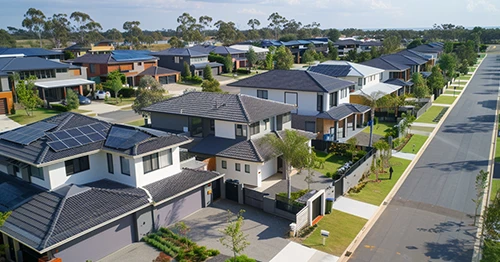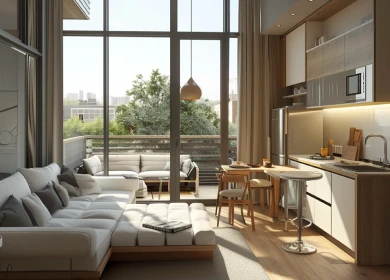Updated: 22 Aug, 2024
Is the housing boom over?
For some parts of Australia the property market may have reached its peak.
The key for investors is to identify which parts of the market are going to do well and which are a house of cards.
If you’re thinking about buying a new unit or apartment, you may want to think again, particularly buying off the plan. This appears to be the highest risk segment of the property market.
What the experts say
With so many vested interests and bias opinions, it’s hard to know who you can trust for real predictions about Australian real estate.
QBE LMI is one of Australia’s largest mortgage insurers and they’ve just released the Australian Housing Outlook 2016 report in conjunction with BIS Shrapnel.
QBE have no vested interest in your property decisions: it’s just research and data.
The great news is that QBE stick their neck out and make a prediction about what will happen in each major property market over the next three years!
Sydney
What to avoid: Inner city apartments and off the plan purchases.
What may be a good buy: Outer Sydney suburbs such as the Hills district and Western Sydney have maintained growth of 3.9% and this looks to continue.
Investment sentiment is particularly strong in areas like Parramatta, Strathfield and Ashfield.
Likely future prospects: 0.2% growth for houses over the 3 years from 2016 to 2019 and -6.8% for units over the next 3 years (note that new units may skew this figure).
Find out more on page 30 of QBE’s report.
Brisbane
What to avoid: Inner city apartments and off the plan purchases.
What may be a good buy: Median house price growth in 2015/16 has been strongest in Inner Brisbane 7.6%.
This means growth prospects look good for Bowen Hills, Fortitude Valley, Highgate Hill, Kelvin Grove and Spring Hill. In particular, look at suburbs that are going to benefit from planned infrastructure projects.
Likely future prospects: 7% growth for houses over the next 3 years and -10% for units over the next 3 years (note that new units may skew this figure). However, investment prospects will be dampened by weak employment figures.
Find out more on page 41 of QBE’s report.
Melbourne
What to avoid: Inner city apartments and off the plan purchases.
What may be a good buy: Median house price growth in Outer Melbourne was 10% in 2015/16 as stronger price growth moved into the more affordable regions.
Keep your eye on suburbs like Greenvale, Sunshine and Hoppers Crossing.
Likely future prospects: House price growth predicted to fall by -0.6% over the next 3 years and -9% for units (note that new units may skew this figure).
Find out more on page 36 of QBE’s report.
Adelaide
What to avoid: While the city doesn’t experience the same level of development projects, the median growth price for inner city apartments is expected to remain flat going forward. This is largely due to tighter lending restrictions for investors.
What may be a good buy: Middle and Outer Adelaide have seen growth of 2.7% and 2.1%, respectively.
At the moment, investor sentiment is high when it comes to the suburbs of Hewett, Hahndorf, Victor Harbor, Brahma Lodge, Salisbury Downs and Paralowie.
Likely future prospects: -1.3% growth for houses over the next 3 years and -0.6% for units (note that new units may skew this figure).
The South Australian economy is expected to suffer growth pains with the manufacturing sector struggling with the relatively high Australian Dollar.
Several public engineering construction projects have also been completed so there will push down employment growth.
This will in turn affect investment opportunities in Adelaide.
Find out more on page 47 of QBE’s report.
Perth
What to avoid: Inner city apartments and off the plan purchases.
What may be a good buy: It may be best to wait but Middle and Outer Perth suffered less of the brunt in terms of growth decline (-5.2%).
Keep a good eye on Koongamia, Gosnells, Stratton, Maddington and Lockridge because investment prospects may improve.
Likely future prospects: -2.4% growth for houses over the next 3 years and -5.7% for units (note that new units may skew this figure).
Mining investment has rolled back along with engineering construction projects. The economy is seriously struggling in Western Australia.
Find out more on page 50 of QBE’s report.
Hobart
What may be a good buy: Growth has been strongest in Hobart (10.1%), Clarence (8.4%) and Kingborough (6.9%). Meanwhile, Glenorchy (1.1%) and Brighton (2.8%) saw more moderate house price growth.
Inner city apartments and off the plan purchases look strong but housing looks like a much stronger investment opportunity.
Likely future prospects: 12.5% growth for houses over the next 3 years and 4.5% for units (note that new units may skew this figure).
The Tasmanian economy looks set to improve with increased household spending, greater commercial property development and an increase in exporting.
Find out more on page 54 of QBE’s report.
Canberra
What to avoid: Inner city apartments and off the plan purchases.
Likely future prospects: 8.5% growth for houses over the next 3 years and -3.7% for units (note that new units may skew this figure).
Find out more on page 57 of QBE’s report.
Darwin
What to avoid: Inner city apartments and off the plan purchases.
What may be a good buy: Inner and Northern Suburbs suffered less of the brunt in terms of growth decline (-2.7% and -2.8%, respectively).
While it may be best to wait, Malak, Millner and Karama have the strongest potential for a bounce back.
Likely future prospects: -6.3% growth for houses over the next 3 years and -10% for units (note that new units may skew this figure).
The Darwin economy, particularly its mining sector, has suffered dramatically due to lower commodity prices.
This has in turn affected population growth and seen more people leave the Northern Territory completely.
Find out more on page 59 of QBE’s report.
Why is there an oversupply of units?
The simple answer: there just isn’t enough buyers for the demand.
Part of this has been driven by stricter foreign investment lending policies.
Foreign investors just aren’t there to pick up the slack in buying up these new units.
In saying that, most banks have always been risk-averse to high density units due to their fluctuating values during peaks and troughs for demand.
How have banks reacted?
The real estate market is being flooded with cheap units and its likely prices will continue to drop as demand slows.
This represents a huge risk to banks!
If they had to sell the property in the event that you couldn’t pay your mortgage, they would be concerned that they wouldn’t be able to recoup their losses.
Some specialist lenders are willing to lend against these property types but they’ll charge a slightly higher interest rate.
Besides that, even they have limits to their appetite for risk.
What are they predicting for the future?
The housing boom has peaked and will likely go flat over 2017 and then decline in 2018. That’s according to a recent report by Morgan Stanley.
Much of this decline is being driven by the continued development of apartment units despite signs that it will far outstrip buyer demand and population growth.
By 2018, it’s expected there will be an oversupply of around 100,000 dwellings, with the majority of this coming from Sydney and Melbourne.
“The greatest vulnerability is settlement risk on the 160,000 apartments we forecast being completed through the end of 2017,” the report stated.
“Settlement risk” means that the likelihood of these home loan applications getting approved is getting tougher as banks tighten their lending policies.
What does oversupply mean for interest rates?
The slowdown in apartment developments would likely see as much as 200,000 jobs at risk and push the unemployment rate up to 6.5 per cent, according to Morgan Stanley.
Any eventual downturn in the Australian economy would likely see the Reserve Bank of Australia (RBA) cut the interest rate in the second half of 2017.
Morgan Stanley has predicted that the cash rate could fall as low as 1.00%. That’s great news for interest rates!
Disclaimer
We can’t predict the future. It’s great that QBE has released their predictions and this may help you to avoid high-risk properties; however, you should do your own research and make your own investment decisions at your own risk.
This article isn’t financial or investment advice. Please speak to a qualified professional if you seek personal advice for your situation.





